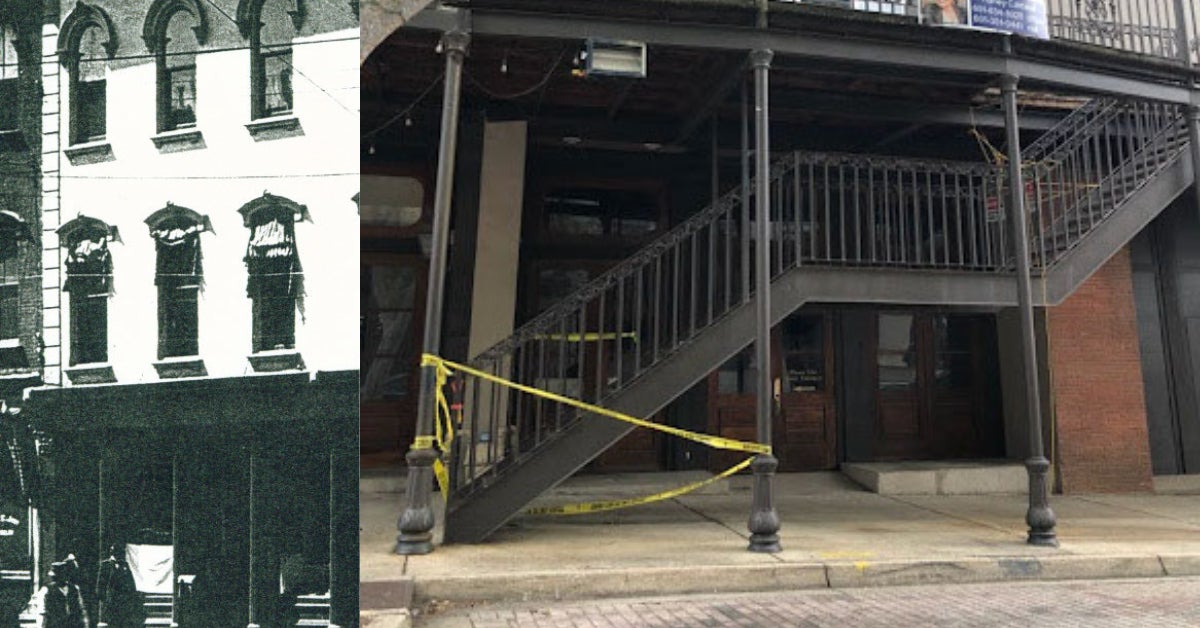LOOKING BACK: 1304 Washington a who’s who of Vicksburg’s merchant history
Published 8:00 am Wednesday, March 22, 2023

- LEFT: The storefront at 1304 Washington St. was constructed sometime in the 1860s and has housed a variety of downtown businesses. (Photo Submitted) RIGHT: The building at 1304 Washington St. is vacant today and available for rent. (Photo Submitted)
By Nancy Bell, Vicksburg Foundation for Historic Preservation
The address 1304 Washington St. is the southernmost storefront of the building on the southwest corner of Washington and Clay streets.
Most likely constructed in the late 1860s, this three-story building was known as early as 1869 as the Vicksburg Bank Building and the “iron front block.” Previous articles have discussed the occupants of the other storefronts — 1300 and 1302 — and this article covers the final storefront, 1304.
By 1869, E.L. Hall Liquors was selling foreign and domestic whiskies, wines and brandies on the first floor with offices on the upper floors, including Cooley Mann (in 1873), who was a justice of the peace and notary public.
In 1874, M. Durner operated his cigar factory on the first floor. An ad in the Vicksburg Herald announced that Durner would “offer for 30 days 150,000 cigars at cost, in order to make room for fall stock.”
The paper announced that J.B. Gotthelf and Co. Jewelers would open its new store in the storefront in January 1881, but by 1883, they had moved and Clarke and Company Booksellers and Stationers had moved in.
An article in the Vicksburg Evening Post in July 1883 reported that Clarke and Company was “in their newly and elegantly fitted up store where everything looks as fresh and bright as a May morning. A view of this large establishment will show that everything has been arranged in the most convenient manner, and on their counters and shelves can be found anything in the book and paper line, as well as all kinds of blank books, stationery and all the etceteras that are necessary for office use, while also can be found musical instruments, croquet sets and baseball supplies. While speaking of this elegantly fitted-up store we must not forget to mention that the elegant job of painting that adorns the front is the work of that artistic painter Col. Wm. French, who seems almost to have surpassed himself in the beautiful marble finish which he has given the front.”
He must have painted the façade by marbleizing it in blue because the store was known as the “Blue Front Bookstore” for many years. The upper floors were occupied by a number of people over the years including Mrs. J.A. Jackson who opened a room for dressmaking in 1887; attorney J.B. Blackwell; Dr. W.H. Hickson, a doctor from Memphis who specialized in piles and all rectal diseases; and John Halpin, an insurance agent.
In April 1892, work was in progress to turn the first floor into Landauer and Partee Confectionery, but the fixtures and showcases were aboard the steamer Golden Rule in Cincinnati when it burned at the wharf, delaying the opening of the new store.
Landauer’s added a restaurant to its candy store in November 1892. The Daily Commercial Herald reported on November 1 that it “was opened yesterday with a very elegant equipment of table-ware, etc., besides all the delicacies obtainable in the market. Oysters, crabs, shrimp, fish of the finest quality and game when in season will be specialties of this restaurant and a large shipment of these luxuries will be received from the Gulf Coast today.”
The business was in financial trouble early on and nine months later Henry Yoste moved his jewelry store from across the street into the building. Yoste was still there in 1906 when the upper floors were filled with the offices of Klein, Moore and Lum Insurance, the Vicksburg Board of Trade, the Vicksburg Wholesale Grocers Association and the Credit Clearing House.
Above Yoste in 1911 were the offices of Calvin Barbour, an attorney and notary, and John Piazza, a justice of the peace and notary. They were gone by 1914 and the upper floors were listed as vacant.
In 1921, L.J. Gilbert, a dentist, and the Loyal Order of Moose occupied the floor above Yoste Jewelers. Yoste was still in the city directory at this location in 1935, but by 1947 was not. By 1951, the Office Supply Company of Vicksburg was operating out of the first floor and it remained there into the 1960s, even after the third floor was removed following the 1953 tornado. The building remains today.




